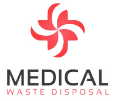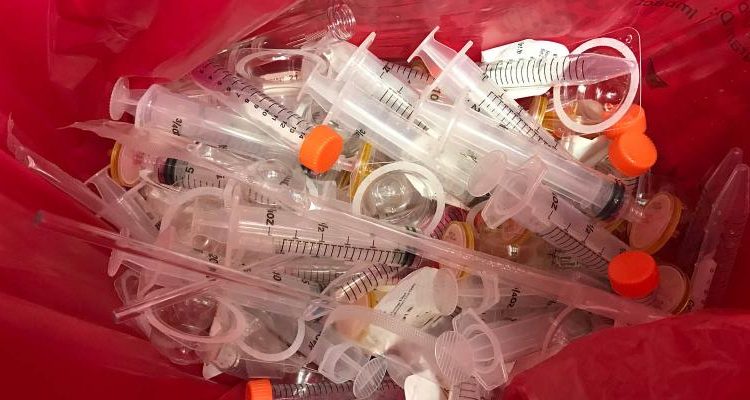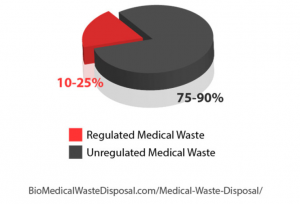t’s important to know what kind of medical waste your facility produces then you can determine the proper disposal. The WHO classified the medical waste into eight (8) categories of medical waste:
- Infectious waste – Waste that may transmit infection from virus, bacterial, parasites to human, i.e.: lab cultures, tissues, swabs, equipment and excreta
- Sharps – Sharp waste, such as needle, scalpels, knives, blades, etc.
- Pathological – Human tissue or fluids i.e. body parts, blood, other body fluids
- Radioactive – Unused liquid in radiotherapy or lab research, contaminated glassware, etc.
- Chemical – Expired lab reagents, film developer, disinfectant
- Pharmaceuticals – Expired and contaminated medicines
- Pressurized containers – Gas cylinders and gas cartridges
- General waste (UMW) – No risk to human health because no blood or any related bodily fluid, i.e.: office paper, wrapper, kitchen waste, general sweeping, etc.
Because the management for every waste categories are different.
Stages of Houston medical waste disposal

Where does medical waste go? How is medical waste disposed of? For purposes of this guide, we are going to focus on disposal in the US. Let’s share with you the cautious and special care process in which medical waste is collected, stored, transported and treated with.
Stage 1 – Collecting & Segregating The biomedical waste has to be collected in containers that are resilient and strong from breakage during the handling process. Do not place sharps, used needles, syringes, or other contaminated tools in common waste disposal or recycle bin because the entire waste will be infectious by doing so. The segregation also needs to be performed between the liquid and solid biomedical waste products. Categorizing the medical waste with correct segregation to isolate and manage each waste in the proper way. For this purpose, the segregations come in colored waste containers, label coding and plastic bags.
Stage 2 – Storing & Transporting Unique requirements pertaining to storage services, such as a secure area which is inaccessible to everyone, as effectively as separated from areas pertaining to food consumption. The storage facilities also have to be accompanied with a fridge or freezer unit that can be used with medical waste in the event necessary. Several facilities perhaps provided particular vehicles and protective devices to dispose, handling or perhaps transport this biomedical waste products. Remember to watch and maintain this protective devices periodically so it won’t become a source of transmitting the infections.
Stage 3 – Treatment

The needs of expert handling that work concurring the by-law regulation, for example, the OSHA are expected to guarantee that the controlled regulated medical waste (RMW) is taken care of legitimately. The treatment procedure will utilize a few medicinal waste equipment that ranged from handling, carts, shredding, conveying, size reducing, compactors, to sterilization or recycling. The following equipment is expected to legitimately prepare the waste in order to reduce the hazards, and keep up the environment:
- Carts and containers – regularly used to gather the medical waste i.e. dumpers, compartments, compactors can be utilized to gather the medical waste
- Conveyors – this gear isolate the waste
- Sterilizers – for example, autoclave, shredder, and size redactor
- Handling the waste – for example, compactors, holders, pre-crushers, and deliquefying framework
- Recycling system – i.e. balers and size reduction equipment
Incineration – Type 1 of Medical Waste Treatment The incineration technology used a high temperature thermal process that can convert inert material and gases with the combustion process. It will process the waste to convert into ash, gas, and heat. There are three types of incinerators that are commonly used for biomedical waste:
- The Multiple Hearth Type – it has a circular steel furnace that contains solid refractory hearths with a central rotating shaft to convert the waste into ash
- Rotary Kiln – it is an incinerator, shape like a drum, commonly for medical and hazardous waste
- Controlled Air – there are two process chambers that will handle the waste. The complete combustion and oxidizing it, leading to a stream of gas with carbon dioxide and water vapor composition. It is commonly used for waste that has organic materials.

In addition, for some cases, performing a shredding for biomedical waste needed as an aid for incineration process.
Non-Incineration System (Autoclaving, Irradiation, Chemical Methods) – Type 2 of Medical Waste Treatment
Aside from the incineration technology, the non-incineration method also provided to dispose the biomedical waste, it contains four basic processes such as thermal, irradiative, chemical, and biological.
The autoclaving system (a photo of our autoclave machine is below) is commonly used for the human body fluid waste, sharps, and microbiology laboratory waste. This system requires high temperature (thermal) that produces steam to decontaminate the biomedical waste. The steam plays a critical role in the medical waste autoclaving process therefore a good waste holding container is required.
Some of human body fluid waste incorporate the use of this method, however the cytotoxic agents that used for chemotherapy cannot use this method due to those kinds of waste are definitely not degraded with autoclave steams. Beside autoclaving, irradiation will be the other thermal method which runs on the high frequency microwave pertaining to disposal. The wave will probably generate heat towards waste materials and kill every one of the bacteria, or some other contamination in the equipment.

Another way regarding performing treatments pertaining to biomedical waste is actually chemical decontamination, this method can be utilized for microbiology laboratory work waste, human body, sharps and body fluid waste, but is not used for the treatment of anatomical waste. Aside from that, biological processes can be a method that employs enzymes to destroy the organic matter in the waste, however you can find very few non-incineration technologies happen to be based on this kind of biological method.
On-Site and Off-Site Treatment of Medical Waste
To differentiate which biomedical waste that can be performed on-site and off-site is important. Because in majority of the cases, the biomedical waste is a mixture and can be very difficult to manage it properly or even to segregate it, which is why an accurate simplified management of medical waste in segregating it according to the regulations will reduce the erroneous element. The on-site treatment usually requires expensive equipment. Not all facilities have this due to major infrastructure expenditure, but it is generally cost effective for very large hospitals and laboratories.
Thus most medical waste producers choose off-site treatment known as regulated Houston medical waste disposal companies because these companies have:
- The proper medical waste equipment
- Been state certified operating permits
- OSHA-trained personnel to collect, transport or store the medical waste

Once treated, the medical waste can be disposed of.
Stage 4 – Disposal
In the US, for solid waste, once medical waste producers have adhered to regulations for collecting, storing, transporting, and treating their waste, they may then use their municipal landfill and sanitary sewer system as their final disposal method.
That’s right, your local municipal landfill is commonly used as the final place of your treated decontaminated biomedical waste.
For fluids such as blood, suctioned fluids, excretions and secretions, almost every state and local government has its own regulations and guidelines to provide the best way to dispose it. In general, there are two recommended ways to handle medical waste fluids:
- Collect fluids in a leak proof container, and solidified for autoclave treatment
- Thermally (autoclave) fluids then they be disposed into the sanitary sewer system
An extra precaution should be performed before pouring treated fluids in sewer because they may clog and leak.
Conclusion
As you can see, great health care adopts into disposing of medical waste, and the approach it can be disposed relies on what category of medical waste materials it is along with federal government laws. Hopefully you will it easier to proper dispose of your medical waste.

Dr. IntanAirlina is consulting Director of OSHA Compliance for BioMedical Waste Solutions, LLC. She is an Internist that holds an Internal Medicine Degree from University of Indonesia, learned tropical diseases and infection, also certified in patient safety from a Joint Commission International (JCI) and ISO certified hospital.


